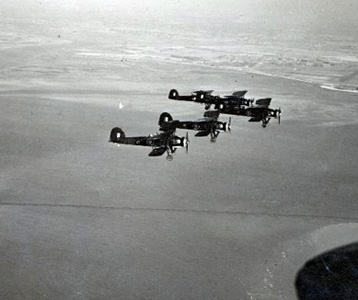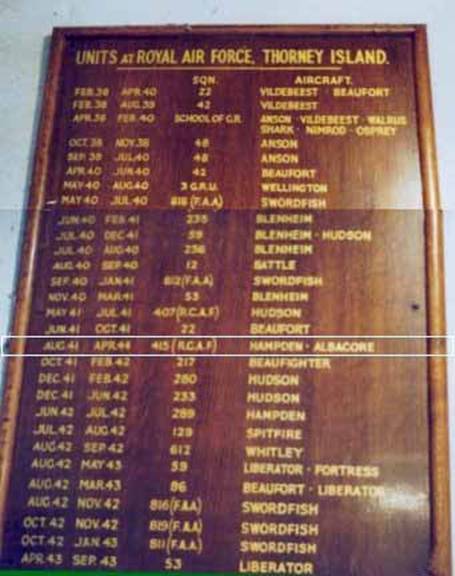|
On
3rd March at Le Havre John Lisle's luck ran out when the barometric
pressure on the other side of the Channel caused his altimeter to mislead
him, and losing height to drop his mine correctly he flew into the sea. He
and his Air Gunner Pat Solway, a cheerful and lovable Glaswegian survived
in the dinghy, but Paddy Allen did not make it. The most John could do was
to let off flares when the following aircraft G for George arrived to let
us know that there were survivors. Four nights later Reg Singleton
returning from
Cherbourg
at the same time as a German air raid, found himself blinded by our own
searchlights which at his slow speed stayed with him, forcing him to
ditch. After five hours in the dinghy in the Channel he was picked up and
taken to the
Isle of Wight
. Next morning G for George flew over to pick him up, and he was never so
glad to see Johnstone and Taylor as then. Sadly, his Observer Billy Muir,
and his Air Gunner L/A George, were both drowned. It was ironic that none
of the men who died did so at the hands of the enemy. Lisle and Solway
went to P.O.W. camps, the former till the end of the war. Pat Solway was
taken ill in captivity and invalided home. He was lost sight of till the
1980s when John Lisle initiated a search which located him in
Glasgow
still suffering from a chest complaint, from which he died in 1983. In his
last years he took an interest in the doings of his former mates, by
letter and telephone with John Lisle, Jim Palmer and John Taylor.
We
were very saddened by these losses and the manner of these misfortunes,
and though the move from Thorney on l3th March absorbed some of the shock
nothing could hide the fact that there were three absentees from the crew
room. Billy Muir was the youngest of our group, but behind his boyish
looks and slim figure there was a keen and competent Observer. His good
humour, sense of fun and ready wit made him a most pleasant companion. He
was intelligent, and his modesty and moderation in all things made a conÂsiderable
contribution to the civilising tone of the Squadron. Paddy Allen,
extrovert and athlete, was a 'character'. Very bright, sometimes blunt, he
was a good man to have on your side, and often his very 'Rashness' proÂvoked
laughter where anger had been intended. In the mess, in the air, or on the
rugby field, this surely was a 'broth of a boy' and as an Observer the
perfect foil to John Lisle so that the pair transmitted the impression of
a zany, crazy outfit.
If
there is more to tell of John Lisle it is mainly because he has survived
to tell it. His war time experiences would fill a book and his pre 836
record would quickly depress any aspiring Observer. he joined the Navy in
1939 and soon found himself ‘stooged’ into teaching his
sea-scout semaphore to recruits at Bullins, Skegness, where the new
sailors learned their boat drills in rowing boats on the swimming pool
with holes bored in the blades of the oars to simulate the real thing.
Thence to Ack-Ack duty
on
North Sea
coastal convoys - uncomfortably dangerous as a career, but less so than
some of the devices invented for him to use. One of these consisted of
lengths of wire at the end of 200 feet of twine projected into the air by
a pistol. The tug of the twine on the operator's finger pulled
the pin on a grenade which fired off the lengths of wire. The idea was to
tangle those wires round the propeller of the dive-bombing attacker.
Depressed when a drunken skipper told him of the courage of his
predecessor and pointed out the bullet holes on the poop as proof, John
left the D.E.M.S. disenchanted with the prospect of 'pooping' off at
Stokes from the poop deck indefinitely. He was persuaded to try for the
F.A.A. The drill, he was told, was to know the answers to two trigonometry
questions, sin/cos equals tan, and Pythagoras. He applied, and though he
thought he would be rejected for his lack of Secondary School
qualifications (he had left school early), he got his interview. The
trigonometry questions came in the right order, and he was accepted. It
still amazes him how this happened, and even more so how he passed his
flying course. One of the many things John couldn't do was navigate.. He
found his way by railway lines, and when they disappeared or crossed he
became confused. He would land at the first airfield he saw, ask for his
plane to be checked and go to the main building to find a notice
indicating its location; then take off to the nearest railway line and
start again.
John's
first prang was on a trip from Netheravon to Hendon when, confronted by
the London Balloon Barrage, he turned north into a snow storm,
force-landed in a snow covered field and turned his Hawker-Hart over. Then
he travelled from the local station (taken there by an obliging land girl)
to
Wimbledon
carrying flying helmet and parachute. There, taken for a German
parachutist, he was put in a cell at the police station to await the
arrival of Special Branch at midnight. Soon John was sent to the Ark Royal
where, as we have seen, he piloted James Turner on occasions. His first
landing on
Ark
was spectacular in that he missed all the wires and stopped two feet short
of the forward end of the flight deck. On another occasion, about to fly
on to the
Ark
from
Gibraltar
he saw the great ship torpedoed before his eyes, and later taking off at
night he had another escape when at full throttle his port wing hit a
Fulmar which had been left parked with its nose on the runway. The crash
ripped the site of his cockpit away. His passenger, an Engineer Commander,
disappeared into the night, his discarded helmet and parachute marking his
terrified flight to safety. Back in
England
piloting a new Walrus from a
Midlands
factory to Lee (sans compass) he found himself enveloped in fog and
force-lanced on St.Catherine's Hill in Hampshire, misjudged the contours,
and after a downhill slalom pitched up by a hedge next to a convenient pub.
And
so when John joined 836 he had many experiences behind him, to which were
then added those previously recorded - in a field short of the Lee
airfield and on the shoreline of Argyll. Thus his luck really did run out
in
Le Havre
harbour. It was later rumoured, apocryphally, that John applied to the
Germans for repatriation on the grounds that he would be more useful to
them as an F.A.A. pilot than as a P.O.W.
|



A.jpg)
